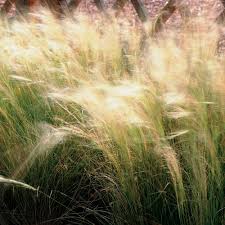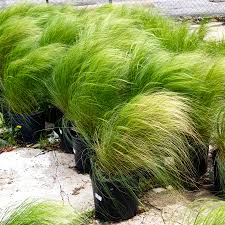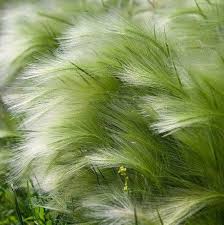Feather Grass, scientifically known as Stipa, is a type of plant that looks like soft feathers. It is often found in grasslands and meadows. The scientific name helps scientists talk about the plant in a precise way. Feather Grass sways gently in the wind, creating a soothing and calming sight. Its slender stalks and feathery tops give it a unique appearance.
With its slender stalks and feathery flowering tops, Feather Grass showcases a delicate yet elegant silhouette. One of its most enchanting features is the way it sways gently in the wind, creating a mesmerizing dance that brings a sense of tranquility to any environment it inhabits. This rhythmic movement is not only visually appealing but also serves as a natural adaptation to its surroundings, helping it disperse its seeds and propagate.
Feather Grass is particularly well-suited to thrive in dry and arid environments. Its ability to endure drought conditions and require minimal watering makes it a valuable plant in regions where water resources are limited. This adaptability allows it to play a vital role in maintaining the ecological balance of its habitat. By providing shelter and sustenance to various wildlife, including birds and insects, Feather Grass contributes to the intricate web of life in its ecosystem.
One of the notable characteristics of Feather Grass is its method of reproduction through wind-dispersed seeds. The lightweight seeds catch the breeze and travel to new areas, allowing the plant to expand its territory and colonize previously untouched landscapes. This strategy showcases the plant’s resilience and adaptability in the face of changing environments.
Gardeners and landscape designers recognize the aesthetic appeal and versatility of Feather Grass. Its graceful and ethereal appearance adds texture, movement, and a touch of whimsy to gardens and open spaces. Whether used as a border plant, an accent in a rock garden, or a focal point in a landscape design, Feather Grass never fails to evoke a sense of natural elegance.
When considering the cultivation of Feather Grass, it’s important to select a suitable location. This plant thrives in sunny spots with well-draining soil. Careful consideration of its requirements ensures that Feather Grass will grow vigorously and contribute its charm to the surrounding environment.
However, Feather Grass, scientifically referred to as Stipa, stands as a symbol of grace and adaptability in the plant kingdom. Its feathery appearance and gentle swaying movement enchant observers, while its ecological role supports various forms of life. Whether in the wild or cultivated in gardens, Feather Grass serves as a living testament to nature’s resilience and beauty.
Read Also: Everything You Need To Know About Grasscutter
Growing Guide of Feather Grass

Feather Grass, scientifically known as Stipa, is a captivating plant that can add beauty and elegance to your garden or landscape. Follow this simple growing guide to cultivate and care for Feather Grass successfully.
1. Select the Right Location: Choose a sunny location for planting Feather Grass. It thrives in full sunlight and prefers well-draining soil. Avoid areas with heavy clay soil or poor drainage, as these conditions can hinder its growth.
2. Prepare the Soil: Before planting, prepare the soil by loosening it to a depth of about 6 to 8 inches. Incorporate organic matter, such as compost or well-rotted manure, to improve soil structure and fertility.
3. Planting: Plant Feather Grass in the early spring or fall when the weather is cooler. Dig a hole slightly larger than the root ball of the plant. Place the plant in the hole and backfill with soil, gently patting it down to remove air pockets. Water the plant thoroughly after planting.
4. Watering: While Feather Grass is drought-tolerant once established, it’s important to water newly planted grasses regularly until they establish a strong root system. After that, water sparingly, allowing the soil to dry out between waterings.
5. Mulching: Applying a layer of organic mulch around the base of the plant helps retain soil moisture, suppress weeds, and regulate soil temperature. Avoid piling mulch directly against the plant’s crown.
6. Pruning and Maintenance: Feather Grass requires minimal maintenance. In late winter or early spring, trim back the dead foliage to encourage new growth. Be cautious not to trim too much, as the remaining foliage provides winter protection for the plant.
7. Fertilization: Feather Grass generally doesn’t require heavy fertilization. You can apply a balanced, slow-release fertilizer in early spring if desired, but avoid over-fertilizing, as this can lead to excessive growth and weak stems.
8. Division: Over time, Feather Grass can become crowded and may benefit from division. Divide the plant every few years in the early spring before new growth begins. Dig up the clump, separate the sections, and replant the divided clumps.
9. Pest and Disease Control: Feather Grass is relatively resistant to pests and diseases. However, keeping the area around the plant clean and free from debris can help prevent potential issues.
10. Enjoy the Beauty: Once established, Feather Grass will reward you with its graceful swaying movement and delicate appearance. It adds a touch of elegance to your landscape and provides habitat for various wildlife.
By following these simple steps, you can successfully grow and enjoy the beauty of Feather Grass in your garden or outdoor space. Remember to observe your plant regularly and make adjustments to care as needed to ensure its health and vitality.
Caring for Feather Grass

Caring for Feather Grass, scientifically known as Stipa, involves a few key steps to ensure its health, beauty, and longevity in your garden or landscape. Here’s a comprehensive caring guide to help you nurture your Feather Grass plants effectively.
1. Watering: Establishment Phase: During the first growing season, water newly planted Feather Grass regularly to help it establish strong roots. Keep the soil consistently moist but not waterlogged.
2. Mature Plants: Once established, Feather Grass is drought-tolerant. Water sparingly, allowing the soil to dry out between waterings. Water deeply but infrequently to encourage deep root growth.
3. Soil and Fertilization: Feather Grass thrives in well-draining soil. Avoid soils that retain too much moisture, as this can lead to root rot. Incorporate organic matter into the soil before planting to improve its structure and drainage.
4. Fertilization: Feather Grass generally doesn’t require heavy fertilization. If desired, apply a balanced, slow-release fertilizer in early spring. Avoid excessive fertilization, as this can lead to overly lush growth.
5. Pruning: In late winter or early spring, trim back the dead or damaged foliage from the previous year. Be sure to leave some foliage at the base of the plant to provide protection during winter months. Avoid cutting too much, as the foliage also adds to the plant’s aesthetic appeal.
6. Mulching: Apply a thin layer of organic mulch around the base of the plant to help retain soil moisture, suppress weed growth, and regulate soil temperature. Avoid piling mulch directly against the crown of the plant to prevent moisture buildup and potential rot.
7. Pest and Disease Management: Feather Grass is generally resistant to pests and diseases. However, it’s a good practice to regularly inspect your plants for any signs of pest infestations or disease. If you notice any issues, address them promptly using appropriate treatments.
8. Division: Every few years, consider dividing mature Feather Grass clumps to rejuvenate the plant and prevent overcrowding. Divide in early spring before new growth begins. Dig up the clump, separate the sections, and replant the divided clumps in well-prepared soil.
9. Winter Care: The foliage of Feather Grass provides some winter protection for the plant. In colder climates, you can leave the foliage intact to help insulate the roots. In very cold areas, you might consider lightly tying the foliage together to prevent breakage from snow and ice.
10. Wildlife Habitat: Feather Grass provides shelter and food for various wildlife, including birds and insects. Allow some of the seed heads to remain on the plant during the winter months to provide a food source for these creatures.
11. Observing and Adjusting: Regularly observe your Feather Grass plants for any signs of stress, disease, or insect activity. Adjust your care routine as needed to address any issues that arise and ensure the continued health and vitality of your plants.
By following this caring guide, you can cultivate a thriving and beautiful Feather Grass display in your garden. Remember that each plant’s needs may vary slightly, so paying attention to your individual plants will help you tailor your care routine for optimal results.
Read Also: A Guide to Growing and Caring for Deschampsia Cespitosa (Tufted Hairgrass)
Benefits of Feather Grass

Feather Grass, scientifically known as Stipa, offers a range of benefits that make it a valuable addition to gardens, landscapes, and natural environments. Here are some of the notable advantages of cultivating Feather Grass:
1. Aesthetic Appeal: Feather Grass adds a touch of elegance and grace to any landscape. Its delicate, feathery appearance and gentle swaying movement in the breeze create a soothing and visually pleasing atmosphere.
2. Low Maintenance: Feather Grass is relatively low-maintenance once established. It requires minimal watering and infrequent fertilization, making it a suitable choice for those seeking plants that don’t demand constant attention.
3. Drought Tolerance: This grass’s ability to thrive in dry and arid conditions is a significant benefit. Feather Grass is well-adapted to drought-prone areas, making it an eco-friendly choice for water-conscious gardeners and landscapes.
4. Wildlife Habitat: The feathery seed heads of Feather Grass provide shelter and food for various wildlife, including birds and insects. By including this grass in your landscape, you contribute to the local ecosystem by supporting diverse forms of life.
5. Erosion Control: Feather Grass can help prevent soil erosion due to its dense root system. When planted on slopes or in areas prone to erosion, it stabilizes the soil and reduces the risk of land degradation.
6. Naturalizing Open Spaces: In meadows, open fields, and large landscapes, Feather Grass can create a natural and unstructured look. Its swaying movement and soft texture bring a sense of wild beauty to these areas.
7. Landscape Design Versatility: Feather Grass is versatile in landscape design. It can serve as a focal point, border plant, or filler in various garden styles, from cottage gardens to modern landscapes.
8. Windbreak and Privacy: When planted in groups, Feather Grass can act as a natural windbreak, helping to reduce the intensity of strong winds. Additionally, it can provide a subtle visual barrier, adding privacy to your outdoor space.
9. Educational Value: For educational purposes, Feather Grass introduces people to the diversity of plant life and demonstrates the interconnectedness of nature. It’s an excellent plant for teaching about ecology and the importance of native species.
10. Hardy Planting Options: Feather Grass is often used in xeriscaping and native plant gardening due to its adaptability. Its hardiness and ability to thrive in challenging conditions open up planting possibilities in regions with harsh climates.
In conclusion, Feather Grass offers numerous benefits that extend beyond its aesthetic qualities. From its ability to withstand drought to its contribution to wildlife habitat, this versatile grass brings both practical and ecological advantages to gardens and landscapes. Whether you’re focused on sustainability, aesthetics, or supporting local wildlife, Feather Grass is a plant that can fulfill a variety of goals.
Read Also: Basic Concepts Underlying Marketing
